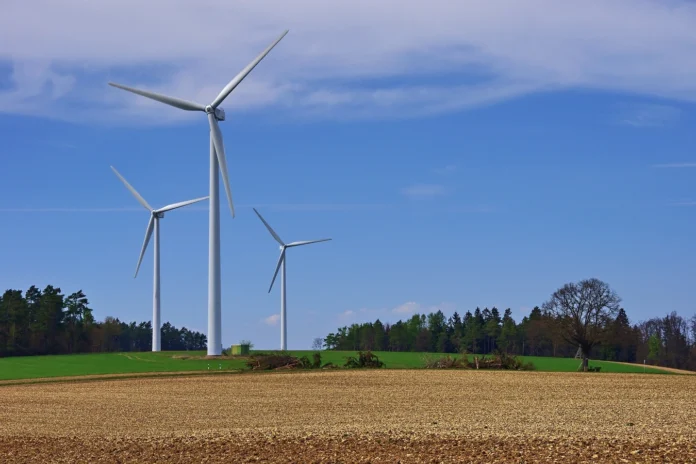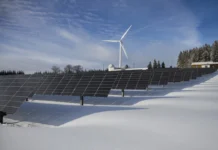In the pursuit of renewable energy sources, windmill energy has emerged as a promising and sustainable solution.
Harnessing the power of the wind, windmills have been used for centuries to generate electricity and pump water.
Today, it has evolved into a sophisticated technology that can power entire communities.
But what exactly is windmill energy? How does it work? And what are the benefits of implementing it on a larger scale?
In this blog post, I will explain the details of windmill energy, exploring its history, mechanics, and environmental advantages.
Join me as I unravel the mysteries of this fascinating renewable energy source and discover its potential to revolutionize the way we generate electricity.
The History Of Windmill Energy
Windmill energy has a long history, dating back thousands of years to ancient Persia.
Early wind-powered machines were used for tasks like grain grinding and water pumping.
The concept of harnessing wind power has been a fundamental part of human innovation
Ancient Persia used vertical-axis windmills as early as the 7th century, marking one of the earliest known instances of windmill energy.
Early windmills used wooden blades to grind grain and perform agricultural tasks.
Over time, windmill technology spread globally, with notable advancements in Europe during the Middle Ages.
Dutch windmills became iconic symbols of innovation.
During the Industrial Revolution, windmills powered machinery and provided energy for various industries.
However, as fossil fuels became more efficient, windmills fell out of favor.
Windmill energy experienced a resurgence in the latter half of the 20th century.
The modern era of windmill energy emerged in the 1970s due to environmental sustainability and the need for renewable energy sources.
Technological advancements, including efficient turbine designs and wind power conversion, enabled the development of wind farms.
Today, it has become a prominent source of renewable power, with wind farms dotting landscapes around the world.
These farms consist of multiple wind turbines, each equipped with large rotor blades that rotate when exposed to wind.
The rotational motion generates kinetic energy, which is then converted into electrical energy through generators.
As the global shift towards clean and sustainable energy continues, windmill energy remains a crucial component of the renewable energy mix.
Its rich history, rooted in centuries of human innovation, serves as a testament to our ability to harness the power of nature for the greater good.
How Do Windmills Generate Electricity?
Windmill energy, also known as wind energy, is a renewable source of power that harnesses the natural force of wind to generate electricity.
So, how exactly do windmills generate electricity?
At its core, it consists of several key components working together to convert wind energy into electrical power.
The primary component is the wind turbine, which typically consists of large rotor blades attached to a rotor hub.
These blades are designed to capture the kinetic energy from the wind as it blows, causing them to rotate.
As the wind turbine blades spin, they transfer their rotational motion to a main shaft connected to a generator.
This generator is responsible for converting the mechanical energy into electrical energy.
Inside the generator, a series of magnets and a conductor coil interact to produce an electric current.
This current is then captured and transmitted through an electrical grid system for distribution to homes, businesses, and other users.
Wind turbines are strategically placed in high wind speeds areas like coastal areas or large plains to enhance wind energy conversion efficiency.
This ensures a steady and consistent source of wind power, allowing for optimal electricity generation.
Wind turbines’ size and design can range from residential-use turbines to large-scale wind farms.
These wind farms often consist of multiple turbines installed near one another, maximizing the collective power output.
In summary, windmills generate electricity by harnessing the kinetic energy of the wind through the rotation of their blades.
This mechanical energy is then converted into electrical energy through a generator.
Benefits Of Windmill Energy
Windmills, or wind turbines, are used to capture the kinetic energy of the wind and convert it into electrical energy.
This type of energy production has gained significant popularity in recent years due to its numerous benefits.
One of the key advantages of windmill energy is its environmental friendliness.
Unlike fossil fuels, which release harmful greenhouse gases into the atmosphere, wind energy is clean and emits zero carbon dioxide.
This makes it a crucial player in mitigating climate change and reducing our carbon footprint.
Additionally, wind energy does not contribute to air pollution, water pollution, or hazardous waste accumulation, making it a sustainable and responsible energy source.
Another benefit of this type of energy is its abundance. Wind is an unlimited resource that is available globally.
As long as there is wind, there is potential for energy generation.
This accessibility makes wind energy a reliable and consistent source of power, which can contribute to energy security and independence.
In terms of economic advantages, windmill energy brings numerous opportunities for job creation and economic growth.
The development, manufacturing, installation, and maintenance of wind turbines require a skilled workforce, leading to employment opportunities in local communities.
Moreover, wind energy projects can provide a stable income for landowners who lease their land for wind turbine installations.
Furthermore, it can help diversify the energy mix and reduce dependence on non-renewable energy sources.
By incorporating wind energy into the grid, countries can decrease their reliance on fossil fuels and promote energy diversification.
This can result in increased energy stability, reduced price volatility, and improved energy security.
The Future Of Windmill Energy
The future of windmill energy is looking brighter than ever.
As we continue to search for sustainable and renewable sources of energy, wind power has emerged as a frontrunner in the race to combat climate change and reduce our reliance on fossil fuels.
Windmill energy, also known as wind energy or wind power, harnesses the natural power of the wind to generate clean electricity.
Large wind turbines, often seen dotting the landscape, are designed to capture the kinetic energy of the wind and convert it into electrical energy through the use of a generator.
One of the major advantages of windmill energy is its abundant availability.
The wind is a constant and renewable resource that can be harnessed in almost any part of the world.
With advancements in technology, wind turbines are becoming more efficient and capable of generating larger amounts of electricity.
Furthermore, windmill energy is a clean and environmentally friendly alternative to traditional forms of energy.
Unlike fossil fuels, wind energy does not produce harmful greenhouse gas emissions or contribute to air pollution.
It is a sustainable solution that helps reduce our carbon footprint and mitigate the impacts of climate change.
Moreover, windmill energy offers economic benefits as well.
The wind industry has created countless jobs in the manufacturing, installation, and maintenance of wind turbines.
It has also provided opportunities for local communities to generate income through the leasing of land for wind farms.
As we continue to invest in windmill energy and develop more advanced technologies, the future holds great promise.
We can expect to see larger and more efficient wind turbines, innovative designs, and increased integration with other renewable energy sources.
The potential for offshore wind farms and community-based wind projects is also expanding, bringing clean energy closer to where it is needed most.
Types Of Windmill Energy
1. Horizontal-axis wind turbines (HAWTs)
These are the most commonly recognized types of windmill energy systems.
They feature a horizontal rotor shaft with blades that rotate around this axis.
HAWTs are designed to face into the wind and are typically found in large wind farms.
They are highly efficient and can generate a significant amount of electricity.
2. Vertical-axis wind turbines (VAWTs)
In contrast to HAWTs, VAWTs have a vertical rotor shaft and blades that rotate around this axis.
They are capable of capturing wind from any direction and are often used in smaller-scale applications, such as residential or commercial buildings.
VAWTs are known for their compact size and low noise levels.
3. Offshore wind turbines
As the name suggests, these windmill energy systems are installed offshore in bodies of water, typically in shallow or deep waters.
Offshore wind turbines are larger and more powerful than onshore ones, as they can take advantage of stronger and more consistent winds found at sea.
They are becoming increasingly popular as technology improves and the demand for clean, renewable energy rises.
4. Floating wind turbines
A relatively new development in windmill energy, floating wind turbines are designed to be deployed in deep waters where traditional fixed foundations are not feasible.
These turbines are anchored to the seabed by mooring lines and float on the surface.
This innovative approach opens up new possibilities for harnessing wind energy in areas previously inaccessible.
These different types of windmill energy systems offer flexibility and adaptability to suit a variety of locations and energy needs.
They play a crucial role in reducing reliance on fossil fuels and mitigating the impacts of climate change.
Windmill energy is a clean and sustainable source of electricity that continues to make significant contributions to our energy transition.
Frequently Asked Questions About Windmill Energy
Considering the popularity of windmill energy, it is natural for people to have questions about its functionality, benefits, and limitations.
In this section, I will address some of the frequently asked questions surrounding windmill energy.
Windmill energy converts wind kinetic energy into electricity using turbines on windmills or wind turbines, utilizing large turbines mounted on tall structures.
Windmills, or wind turbines, use blades to capture wind energy, rotating them to activate a generator, producing electricity that can power homes, businesses, or entire communities.
Windmill energy is a clean, renewable, and abundant source of power, providing a reliable long-term solution for meeting energy demands without causing greenhouse gas emissions or air pollutants.
Windmill energy relies on wind availability, requiring consistent, strong winds for efficient operation. Visual impact and noise concerns may affect communities.
Wind energy is economically viable in some regions, but a thorough analysis of wind patterns and speeds is crucial for selecting the right location for turbine installation.
Wind energy’s cost has decreased, making it more competitive with traditional sources. Despite substantial initial investment, long-term benefits like lower operational costs and government incentives often outweigh the initial cost.
Final Thoughts On Windmill Energy
In conclusion, windmill energy is a renewable and sustainable source of power that harnesses the natural force of wind to generate electricity.
It offers numerous advantages, such as being clean, emissions-free, and abundant.
Windmills have been used for centuries, evolving from traditional windmills used for grinding grain to modern wind turbines used for generating electricity on a large scale.
Windmill energy is particularly beneficial for reducing greenhouse gas emissions and combating climate change.
It also has the potential to create jobs and stimulate economic growth in areas with favorable wind conditions.
While windmill energy has its advantages, it is important to acknowledge that it also has limitations.
The intermittency of wind as a resource means that energy production can fluctuate, requiring backup energy sources or energy storage solutions to ensure a consistent power supply.
Additionally, wind farms may face challenges in terms of aesthetics, noise pollution, and their potential impact on local wildlife.
Overall, windmill energy is a promising and viable alternative to traditional fossil fuel-based energy sources.
As technology continues to advance, we can expect further improvements in efficiency and cost-effectiveness, making windmill energy an increasingly important component of our global energy mix.
By embracing windmill energy, we can move towards a greener and more sustainable future for generations to come.
Further Reading And References
To read more informative articles like this, see the pages below:
“Renewable Energy: Sustainable Energy Concepts for the Future” by Roland Wengenmayr and Thomas Bührke
“Renewable Energy Systems: A Smart Energy Systems Approach” by Henrik Lund


